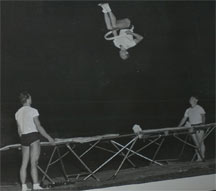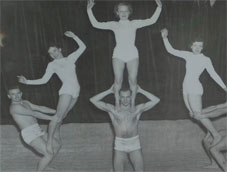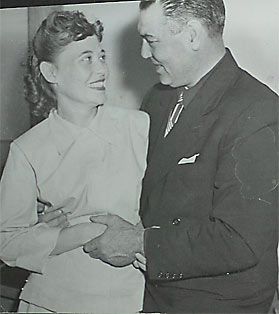
Dr. Eric Lester Hughes
Lee Bjella, 2015
Dr. Eric Hughes was born on 9/1/23. He competed in high school gymnastics in 1936 in Victoria, British Columbia, and also with the BC Provincial Recreation Club. Eric went to college at the University of Illinois where he was coached by the great Hartley D. Price. College was interrupted by WWII, and he enlisted in Canada (R.C.A.F.) as a pilot. After the war he returned to Illinois where he participated in cross country and track as well as gymnastics. During these years, Eric also traveled with a touring acrobatic group called the The Aristocrats of Balance.
Upon graduation, he became a teaching assistant at the University of Illinois for a year and a half as he finished his Masters Degree. Eric then taught at Bemidji State Teachers College in Bemidji, MN. from 1948-1950. He was hired to coach hockey! (Remember - he is Canadian.) He started the gymnastics program there, and also was an assistant coach of the Men's Football Team.
 (Eric with traveling group - he is on right - his first wife is pictured.)
(Eric with traveling group - he is on right - his first wife is pictured.)
In 1950, Eric moved to Seattle and went to the University of WA for their doctorate program and started a children's gymnastics program. Eric also started the UW men's gymnastics team which was officially recognized as a major sport at the University in 1956. His team won the National AAU Championship in 1968 and 1969 and took second in the NCAA Championships in 1965. Some of the more accomplished UW men who Eric influenced were Charley Denny, Mauno Nissinen, Yoshi Hayasaki, Sho Fukushima, Mel Cooley, Jim David, Bob Hall and Steve Wejmar. He compiled a 109-17 record at UW.
He served as President of the National Association of College Gymnastics Coaches and was selected Western Coach of the Year in 1963 and 1965. He was Pacific Northwest AAU Gymnastics Chairman from 1954 to 1963. In 1961 he was the coach of the U.S. team that toured Czechoslovakia, Poland and the USSR. In 1966 He took the Husky Club on a tour of Japan, Australia and New Zealand. In 1968 he took them to many countries in SE Asia and in 1970 to five countries in South America.
 He was the coach of the 1972 Olympic Men's Gymnastics Team in Munich. (pictured at left)
He was the coach of the 1972 Olympic Men's Gymnastics Team in Munich. (pictured at left)
Eric was one of the founders of Gym Kamp (Camp Waskowitz) and held coaches clinics and invitational gymnastic competitions. Two books, Gymnastics for Men and Gymnastics for Girls, plus numerous articles were written by Dr. Hughes.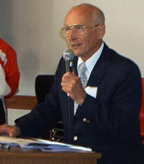
In 1973, he was inducted into the national Helms Gymnastics Hall of Fame. Eric is a (UW) Husky Hall of Fame inductee, and he was inducted into the first USAG WA Hall of Fame 2002. (pictured at right)
From interview with Eric Hughes by Lee Bjella 3-5-02 (Updates in 2003 and 2014)
In conversation with Eric about Hartley Price - his coach at Ill. Champlain -Urbana:
"My education was split by the 2nd World War. I started in 1940 and Coach Price had been a long time coach there. The war came along and he went into the service before I did. I went into the Canadian service. I came back (to college) in 1945. He wasn't back yet - but came back about a year after that."
On other notable gymnasts personalities of his era:
"Chet Phillips coached at the Naval Academy when I started coaching here (UW).Tom Maloney was at the Military Academy. Newt Loken was at Michigan and George Szypula at Michigan State. The top coach and school in the Pac 10 was Hal Frey at Cal. Joe Giolombardo in Chicago was considered the top coach at the high school level."
Talking about 3 books I brought to show him:
(Leopold Zwarg's Apparatus and Tumbling Exercises; Price, Keeney, Giallombardo, Phillips Gymnastics and Tumbling; and Wilbur West's The Gymnastics Manual.) "These were three of the best books of the time and I used them all in my early days of coaching and teaching. I also used a book by Leslie Judd - he's a famous old coach. Judd turned out a lot of good gymnasts and many of his students went on to be gymnastics coaches. Zwargs was the first book I used more than any other."
The summer of 1948:
He was working on tour with a gymnastics act; "Most of our work had been in Illinois, Indiana, Missouri, Wisconsin, and other states right around there. But because I was from the West Coast, I asked our agent to book us out west. He booked us in several shows in WA state, B.C. and Alberta. I had made arrangements to stop at Bemidji for an interview on my way back to Illinois at the finish of our summer tour. I was interviewed by the president of the college there - Sattgast. He hired me right on the spot."
Hughes was at Bemidji State Teachers College from 1948 to 1950. He married one of his students (Rae - his second marriage) there in the summer of 1950. Her last name was Rossbach - her father was full German and mother was half Amercian Indian. She was from the Red Lake Indian Reservation near Bemidji. (Bemidji State University is were this author went to college for a P.E. degree and was on the Women's Gymnastics Team and later was assistant coach and then head coach, but never heard of Eric until coming to Washington!)
Eric loves to canoe, and was very good at it (and still is, even in his 80's at the time of this writing) winning many races until giving up competition in 2003 at the age of 80. He still (as of 2003) teaches at a Seattle club. He raced professionally. One race was from Bemidji (the beginning of the Mississippi River) to Minneapolis, in which he won $2,000 as the second place team. His income from a year teaching at the college was $3,000! He also coached the B.S.T.C. (Bemidji State Teachers College) hockey team the two years he was there. When I asked him, amazed, what he knew about hockey, he turned and looked at me and said, "Well I was born in Canada!". Eric and his wife left Minnesota after the 1950 summer session and he started at UW in the fall. (He hated the deer flies in Bemidji.) (Update, 2015, Eric is now 91 and living in Mill Creek, WA. He had a heart attack in the summer of 2014.)
Here is a good place to tell the story about Eric's first weekend at UW. He went and looked at the equipment and noticed the vaulting horse was the old fashioned kind that had one end that went up. It was no longer a regulation vaulting horse. "So on a Saturday, I went down to the gym with a saw, pulled back the leather covering on the end, cut off the wooden end of the horse, and sewed the leather back down, nice and firm." The next morning he got a call from a very angry Russ Cutler, the head of the P.E. Department, who said "What did you do to my vauling horse!?" Eric laughs when telling this because Russ was so mad. Eric says he told him he was just making it legal.
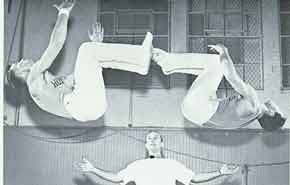 "At the UW in 1950 - The men's program was not a competitive program. It was just a club. Boys and girls were separated in those days. The girls were up in Hutchinson Hall and the boys were in the Pavilion. Once the club got started, there were a bunch of girls up in Hutchinson who really wanted to join, so I said, "Hey! We'll have a co-ed night one night a week. Come on down. We had a pretty good co-educational group going there for a while there and then Ruth Wilson who was the head of Women's P.E. saw my boss, Russ Cutler. (The guy who really flew into a rage when I cut up the horse.) She went to his office and said, "One of your instructors has our girls down in your gym! Men don't know how to teach women. Make him stop this right away." So he called me into the office and he chewed me out something awful. I could tell he was just trying to hold back a laugh. For a while I had to stop having women in our club. We did get approval sometime later, but I don't know how that came about. I guess I had to prove I knew the difference between a man and a woman."
"At the UW in 1950 - The men's program was not a competitive program. It was just a club. Boys and girls were separated in those days. The girls were up in Hutchinson Hall and the boys were in the Pavilion. Once the club got started, there were a bunch of girls up in Hutchinson who really wanted to join, so I said, "Hey! We'll have a co-ed night one night a week. Come on down. We had a pretty good co-educational group going there for a while there and then Ruth Wilson who was the head of Women's P.E. saw my boss, Russ Cutler. (The guy who really flew into a rage when I cut up the horse.) She went to his office and said, "One of your instructors has our girls down in your gym! Men don't know how to teach women. Make him stop this right away." So he called me into the office and he chewed me out something awful. I could tell he was just trying to hold back a laugh. For a while I had to stop having women in our club. We did get approval sometime later, but I don't know how that came about. I guess I had to prove I knew the difference between a man and a woman."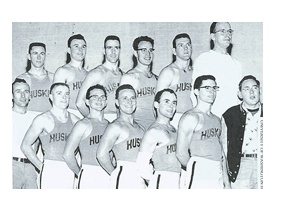
Early History at University of WA
"We first competed in the spring of '51. I entered about 3 or 4 guys in a YMCA meet in Seattle. Gymnastics was more popular in B.C. in the '50's than here. We went up to B.C. and entered a couple of meets in 1952. It was still a club sport at UW. A group of students who wanted to do something, any activity, just formed a group. I don't think we ever signed papers and became an official student club. In 1955 or '56, Harvey Cassell was the athletic Director. He established gymnatics as a minor sport. There were major and minor sports in those days. Three years later we were raised to the status of Major sport. Because I started the program, they called me the "Father of UW gymnastics"! They dropped the program for financial reasons shortly after Title IX was passed by Congress. I think it was about 1980 when it was officially dropped. I resigned as coach two years before it was dropped but stayed on as a P.E. teacher. My assistant in '78-'79 was Dick Foxall. He took over and coached for two years, then he went to Eastern Montana and then to Oregon. Jim Holt was a Washington State Gymnast and Tacoma Lincoln High School gymnast. He had been helping Dick Foxall as a volunteer. When the program was dropped he said, "Hey - let's just keep turning out."
On Augie Auernheimer:
"He was my office partner when I first came to the U. He was an old Turnverein man and was quite elderly when I came, probably in his 60's. He was the oldest guy in the department. He retired right after I came - 1 or 2 years later. He knew something about gymnastics. The best gymnasts were Turners in those days but the Turnvereins were mostly in the East."
On the 1932 Olympics:
"The '32 Olympics were held in the U.S. in Los Angeles and the host country could include events of their choice. Tumbling, although not an international event, was included. I think there were only 4 entries. There were 3 US participants and 1 from somewhere else. Americans won, two out of the three medals."
On George Lewis:
"George Lewis was born in Montana and spent just about all his life in Seattle. He was a gymnast at Roosevelt High School. Later, he took over as a volunteer coach at the Seattle "Y". I moved to Seattle in 1950, working on my doctorate program, and everyone said you've got to meet George Lewis. You and George are exactly the same. About three months later I finally met George. We became friends and tried to coordinate our programs. I had started a children's program for boys. I kept getting calls at the University from parents. "Can't you take girls?" "No, I'm not allowed to have girls in my gym." I finally talked to George and asked if he could have girls in his program down at the "Y". He said, "Sure I can have girls." So I said why don't you specialize in girls and I'll work with the boys and we'll have both a boys and a girls program going." (This is about the time that Eric wrote an article on George called "George Switches To Girls." for the WA. State Bulletin).
On girls gymnastics:
"Women's gymnastics was very new. Anyone like George with a good gymnastics knowledge had a great advantage. His girls got better faster than anyone else's! At one National Championship his girls took 1st, 2nd, 3rd and 5th in the all-around. Can you imagine that - in a National Championship meet, he took 4 out of the 5 top places in the all-around. George's teams won the National YMCA Championships year after year. This would have been in the '60's or '70's. Joyce Tanac, Dale McClements (Kephart), Carol Camp, Lonna Woodard, Cleo Carver. Linda Rodella were some of those early top performers. Laurel Anderson (Tindall) now coach at Seattle Pacific University, was a little after these girls. Carolyn Pingatore was in that group. She is still around. She works for Albert Rossilini, former governor of the state. I talk to Ping every once in a while."
On creating the gymnastics program at UW:
"Paul Smith came about one year before I did and had a gymnastics background from Southern Illinois University-Carbondale. Hubie Dunn, coach at WSU also went to Southern Ill. I think they knew each other there. Paul taught gymnastics classes, but didn't seem to have the interest to start a compeitive gymnastics program. And when I came, I did have that drive. That was definitely one of the things that I wanted to do."
After considerable pressure from the community I started a children's program for girls on Saturday mornings in Hutchinson Hall but I didn't teach it myself. The first person I hired for that was....I can't remember. Three different women who did teach the classes over the years were Ann Cannon, Carol Elsner and Linda Luna. The girls program was run just like I ran my boys program. I was the coordinator for it because I was on the faculty and it was run through the University Extension program."
 "Carol Eisner was a good gymnast, good dancer. She actually went to New York at the ripe old age, like in her 30's, to become a professional dancer. Linda Rodella Luna was a good gymnast. Ann Cannon was one of the pioneer coaches for girls in the Northwest."
"Carol Eisner was a good gymnast, good dancer. She actually went to New York at the ripe old age, like in her 30's, to become a professional dancer. Linda Rodella Luna was a good gymnast. Ann Cannon was one of the pioneer coaches for girls in the Northwest."
On Balance Rails:
"They had about 15 of these in Hutchinson Hall, about two inches in width. When I started the girls program, I went up on a Saturday morning and I bolted a 2x4 down the top of a balance rail to make it the correct width."
"There was also a boom in Hutchinson Hall which was a huge round timber that was fastened against the wall of the gym. One end could swing out and fastened with cables. This boom could be raised and lowered on the two uprights. Students did uneven bar type stunts on this boom."
On Girls at UW - the early program:
"It was a club, not an official team. It was not recognized by the Athletic Dept. It was somewhere in between "Play Days" that women used to have in that era and where women's athletics are now. In those days university women weren't allowed to compete as a team against other universities but  four or five universities might get together on a Saturday and have a Play Day. Even though the UW did not recognize them as a team, they somehow got permission through the woman's P.E. Department and competed in a few meets representing the U. They placed second in the nation one year."
four or five universities might get together on a Saturday and have a Play Day. Even though the UW did not recognize them as a team, they somehow got permission through the woman's P.E. Department and competed in a few meets representing the U. They placed second in the nation one year."
On his children's program:
"In my children's classes on Saturday mornings we had shirts that specified their levels. In their first quarter they automatically got a UW Beginner shirt. They were advanced by ability. We had Junior, Intermediate, and then Advanced and finally when I started my evening program and had the older kids, they could earn a Leader shirt. I used them to assist in my Saturday classes. They got their classes free for assisting with the Saturday morning classes."
Eric's son Kip, was a gymnast at Hale High School. He ended up coaching in several different Seattle High Schools for a while then moved away.
(Picture at right: Eric with his Exhibition Group in Bemidji, MN. Eric is on the bottom.)
2015 - September
When Eric turned 92, Lee went to lunch with him and his friend Jean. He told her a bit about his Seattle Gymnastics Club trips:
Eric recalled the 1968 Philippines tour. Imelda Marcus gave him a tour of her house. During the Taiwan trip, there were protesters and while the gymnasts were doing their exhibition, they were locked into the exhibition hall. They could hear the protesters pounding on the doors!
During the 1970 trip to Bolivia, Gunter Bohrman and the UW team toured. It was not a pleasure trip by any means. Eric said, "We worked!" They tried to take a day trip to Lake Titicaca to the ruins. They were staying at a military college and they all boarded the military bus. There was, of course, a revolution going on and they traveled up to 15,000 feet and were going across a plateau. They were stopped at a blockade and the interpreter told Eric to go out and talk to the soldiers. Eric got off the bus and immediately had a machine gun in his belly. Eric explained what that they were a gymnastics exhibition group and that they wanted to see the ruins. Finally the soldier said he would let them continue, but that there was another checkpoint five miles ahead and they might not be so nice. They turned around and headed back to the college. He mentioned that 13 year old Peggy Rowan was with on the trip and he was given power of attorney. She was the main reason he felt he needed to turn the bus around. He said Peggy was such a good gymnast they wanted to take her on the trip.
Early Bemidji State College Sports, 1948-1950 - Scenes from 1940-1950's Memorial Hall:
Eric went to Bemidji State Teacher College (later Bemidji State University) in Bemidji, Minnesota. Eric was head Hockey coach, and
assistant Football coach. When he worked there, he was one of five P.E. teachers/coaches and the department was located in old Memorial Hall. The hall is still there today, but there hasn't been a gymnastics team since the mid-1980's - either men's or women's. He started the gymnastics program and a traveling exhibition team. (This author, Lee Bjella, was a P.E. major and member of the Women's Gymnastics Team there and then assistant and then head coach for one year. Thanks for starting the program there Eric!) Photos from Eric's collection, used with permission.
|
|
Eric in air |
|
|
Rae Rossbeck - (Eric's future wife) Eva Kuznia, Joyce Ajkelin, Mary Spillone, Jean Sanberg, Glenn Hymer, Bruce Jamieson, Harold Westby, Ed Slovag, Bill Carlson, Rollo Buck |
|
|
Eric is middle bottom, and Rae is the lady on his right.
|
|
Rae and famous boxer Jack Dempsey at BSTC |
Football Program, 1948 - Eric coach 2nd from top |
Eric starting canoe race from mouth of Mississippi River to Minneapolis. Eric and partner won. Eric said he almost earned as much in that race, $2000, than he did teaching and coaching at BSTC that school year! Notice Paul Bunyon and Babe the Blue Ox in background. This is in Bemidji on the waterfront. and Paul and Babe are still there but the Armory is not.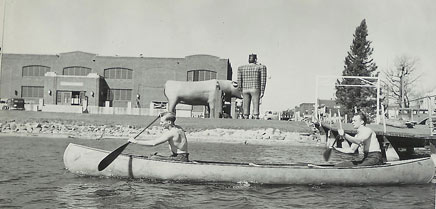 |
Eric - coach of BSC Hockey Team. |
You can read more about Eric in this article: Mill Creek Living Article June 2015

